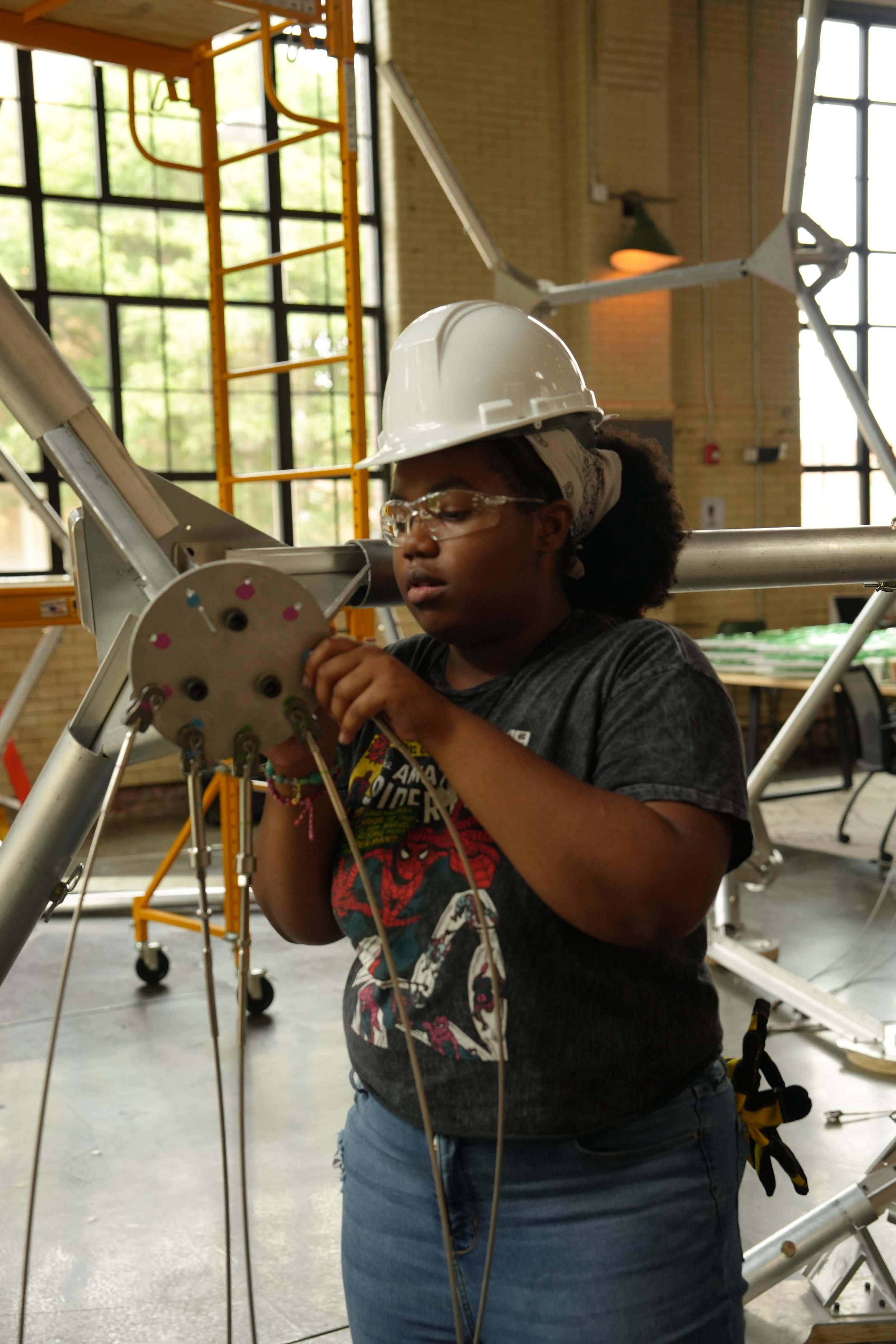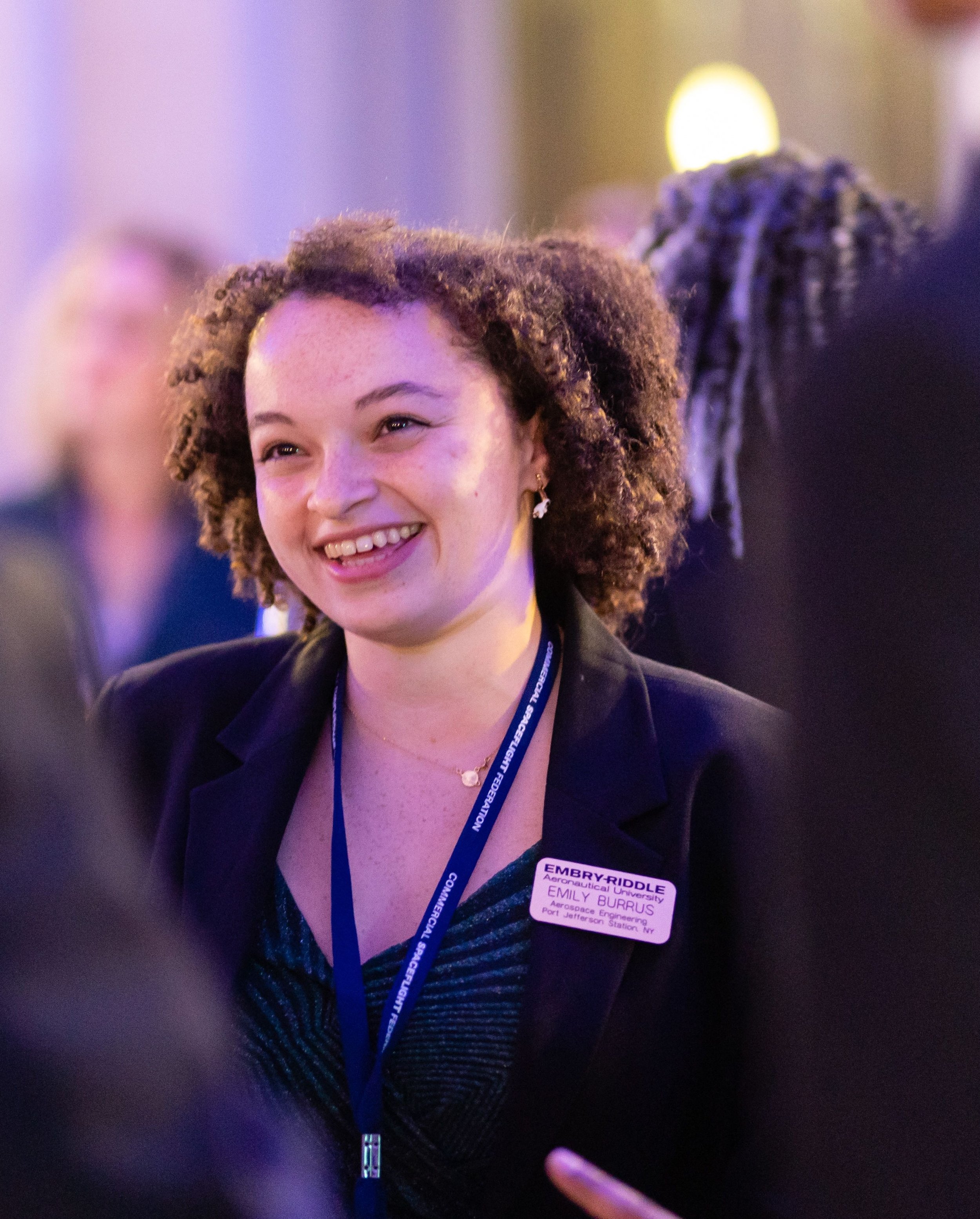Celebrating Aurelia’s 2023-24 interns
Six students and young professionals brought their own expertise and learned through hands-on participation in Aurelia projects
Interns Angelina Zhang and Channelle Taylor work together on the TESSERAE Space Habitat Pavilion.
A core part of Aurelia Institute’s mission is contributing to the development of an inclusive, mission-ready future workforce, on space as well as on Earth. To that end, it’s been our privilege to host a regular roster of exceptional interns from schools and organizations around the world who share our dedication to excellence and diversity in the space industry.
Over the last year Aurelia has worked with six remarkable individuals, each with their own unique stories and contributions. Here, we asked them to share a little about their experiences.
Angelina Zhang
Angelina is a Master of Design Studies (Ecologies Domain) student at the Harvard Graduate School of Design, and joined Aurelia Institute for the summer as a 2024 Community Service Fellowship Program (CSFP) Fellow.
I was inspired by Aurelia Institute's TESSERAE project when I was designing my undergraduate thesis on extreme habitation. This led me to explore more through Ariel's book Into the Anthropocosmos and the Zero G Prototype class at the Media Lab. The institute's research vision aligns closely with my interest in creating resilient and future-oriented habitats for extreme environments.
During my time at Aurelia, I assisted the team in fabricating and building the full-scale TESSERAE Pavilion, while also conducting independent research on general habitat design strategies. My work focuses on how unique environments, like Zero-G, inspire innovative habitat solutions, where architectural spatial design and material science converge to create sustainable living spaces that can thrive in extreme conditions, whether on Earth or beyond.
I'm most grateful for the collaboration with a multidisciplinary team to navigate design challenges. Aurelia's rich network allowed me to set up interviews with individuals experienced in confined environments, participate in creative charrettes, and be hands-on in building the TESSERAE Pavilion. These experiences have been invaluable in teaching me how a team best operates and how to effectively tackle complex design problems.
Interning at Aurelia has been instrumental in shaping my career goals. It has helped me develop my research in designing climate-resilient single-family homes in high-risk areas. I aspire to apply the innovative technologies and principles of space habitat design to make our Earth homes more resilient, durable, and adaptable to the changing environment.
Channelle Taylor
Channelle is an Aerospace Engineering major with a minor in Earth and Atmospheric Physics at Georgia Institute of Technology. She joined Aurelia Institute for the summer as an intern through the Pattie Grace Smith Fellowship.
My research was focused on the application of tile base self-assembling technology on other planetary bodies, specifically the design, dimensions, features, systems, power, mission, etc. I assisted on creating an air bearing table for free floating tile testing. I also assisted on the fabrication and build of the TESSERAE Pavillion.
Building the Pavilion was very inspirational and educational. It gave me a real-life feel not only for TESSERAE but for my research as well, and how people in those environments would feel. I immediately began to think of other features that could be added as well as little things that someone living in that space might find helpful. You don't always realize what's missing in your design until it's fully built.
Another favorite moment was getting to present my research at the end of my internship to the Aurelia team. It meant alot to show people what I had been tirelessly working on and get to inspire them a little bit as well.
My current goals are to earn more internships and develop more professional skills and experience in aerospace. My future goal is to one day work on the type of spacecraft that we see in the movies today. Not the exaggerated ones where gravity is created by a "gravity generator" but the ones where gravity is created by centrifugal acceleration, such as the one seen in the movie Interstellar. We have all the technology to build it today......just not the money, legislation, support, and world corporation that it would take to make it possible.
Aurelia has given me a big insight on how it is not only important to design to the requirements but also design with the notion that not only will someone be working in the space, but also living there. There should always be more design consideration than just function and work, there should be consideration for relaxation and mental escape, especially in confined environments not only far away from home but far away from Earth.
Sneha Ramshanker
Sneha is a PhD student at Princeton University, researching how teams of robots can be used to inspect structures in space who joined Aurelia as an intern for the summer. Her primary work involves developing collective behavior algorithms that allow teams of robots to achieve more than the sum of their parts, similar to how biological collectives like ants and termites accomplish remarkable tasks by working together despite their individual simplicity. She adapts these bio-inspired ideas to the field of inspection, demonstrating how teams of robots can inspect complex 3D structures and showcasing these concepts using a swarm of AstroAnts.
I was drawn to Aurelia because I was interested in understanding how we build technology specifically for the space environment and what critical questions must be addressed to ensure technology is space-ready. I was also fascinated by Aurelia's mission of democratizing space and wanted to learn more about this.
During my time at Aurelia I worked on the latest generation of TESSERAE self-assembling prototypes, preparing them for a full-scale mission aboard the International Space Station (ISS). My focus is on integrating optical sensors into the tiles to enable them to detect correct bonding and identify their bonding partners, which is crucial for reliable assembly in space.
Zoe Pizzuti
Zoe recently earned her B.S.E. in Aerospace Engineering at the University of Michigan, and is returning to Michigan to complete her M.S.E. in Aerospace Engineering. She volunteered with Aurelia this spring in order to explore Bioregenerative ECLSS, Space Policy, and Community in Space.
I found out about Aurelia when Ariel visited my university (go blue!), and I felt aligned with their values and mission. In an effort to do impactful work in human spaceflight and space exploration, I was immediately drawn to the forward thinking and creativity that Aurelia applies to their projects.
I learned about the current space policy environment during my time at Aurelia, and I will definitely be taking that with me into the future. It even has me considering studying or working in policy at some point during my career! But my overarching career goal hasn't swayed: I hope to contribute to the cutting edge of space exploration through human spaceflight technologies.
I am currently working on creating the space analogue for key tenets of urban planning with the hopes of developing a set of "ground rules" for developing a larger-scale space community. My current areas of focus for this project are accessibility, sustainability, and third places. In my past work with Aurelia, I completed a literature review of different bioregenerative environmental control and life support systems (ECLSS), reviewed the 2023 Commercial Space Act that was introduced to the U.S. House, and completed a literature review of current U.S. and international policies/practices regarding AI use in space.
Jagriti Luitel
Jagriti Luitel is an undergraduate student at the University of New Brunswick, Canada, where she studies satellite engineering. Jagriti volunteered with Aurelia’s 2024 Horizon cohort, and has continued her involvement with Aurelia through an independent research project.
I have always wanted to become an astronaut but being born in Nepal, the aerospace industry was never accessible to me. Years later, after immigrating to Canada with my family in late 2017, that changed. Aurelia’s core vision of making space accessible for everyone, using space for the benefit of earth, shifting focus from mere survival to thriving and deploying a multidisciplinary approach for low earth orbit space civilization, captured my imagination and completely drew me in.
I completed a zero gravity flight with Aurelia’s 2024 Horizon cohort. My project was wearing a custom-made piece by a space Fashion designer Deborah Won through her new company Pisces Rising. I represented Nepal’s national flower, rhododendrons, on the flight.
My project with Aurelia this summer is an exploration of the potential application of Aurelia’s current space architecture advancements for post-earthquake relief on Earth. It is a socio-technological space policy research project, inspired by my experience with the 7.8 magnitude 2015 Nepal earthquake. My favorite moment was a personal tour of Aurelia's office in Boston. As a remote intern from Canada, it was invaluable to see in person how dedicated everyone is to the organization's mission and vision.
My career goal is to become an interdisciplinary leader in aerospace that focuses on social innovation. My project at Aurelia has definitely propelled this goal, and I hope it will take me to space someday.
Emily Burrus
Emily recently graduated from Embry-Riddle Aeronautical University's Aerospace Engineering Program with a Minor in Space Studies, where she was a Patti Grace Smith Fellow. She joined Aurelia as a volunteer in Fall 2023 to work on the communications team, with a focus on social media. She recently joined Blue Origin as a manufacturing engineer.
I was drawn to Aurelia because I had heard about the groundbreaking work being done in space architecture and policy, and its focus on how humanity can help build the future of space really resonated with me! I thought all the projects were next level in terms of technology development, and the culture at Aurelia seemed extremely inviting and interesting.
I was a communications intern working on sharing more information about the company to various audiences and curating posts for different social media platforms that reflect the company's dedication to its mission through the work accomplished during the year.
My long-term career goal is to be an astronaut! I am working on developing my technical and soft skills through opportunities like this internship. Aurelia has opened me up to the world of space policy, research-based projects, and architecture overall, and these interests I had upon starting the internship have only continued to grow as I learn more about them. Everyone at Aurelia has been so positive and insightful, and it has been a pleasure learning from the industry's best!








